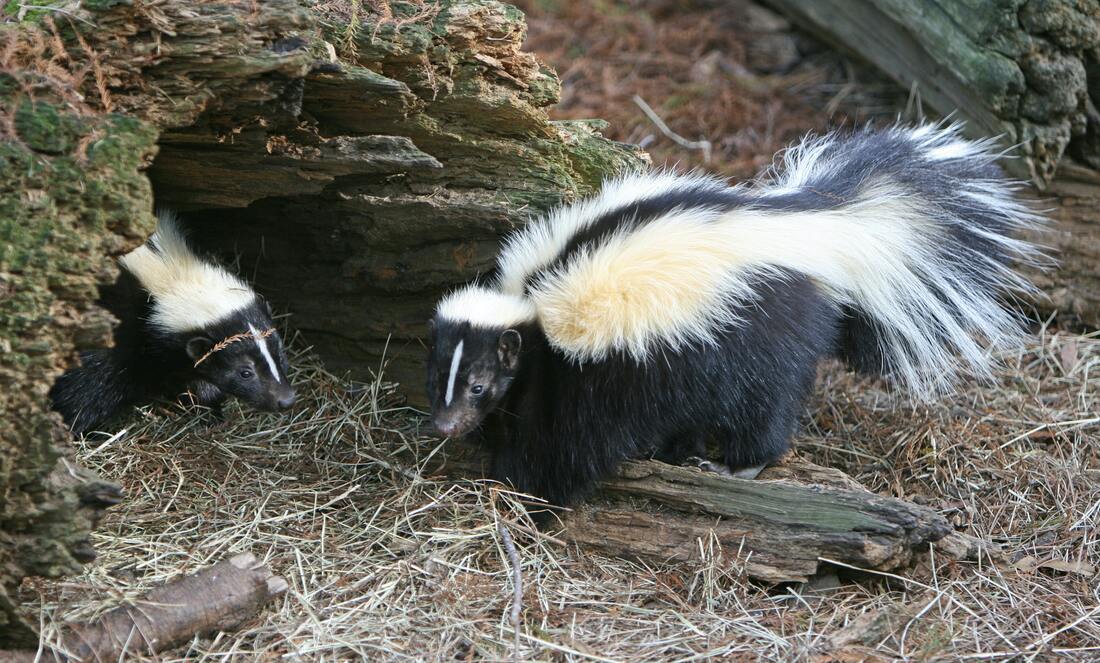Call Today to Speak Directly with Ryan and Schedule your Appointment to Have your Problem Animals Removed
707-761-3055
Skunks in California
- There are 2 species of Skunks found in California, the Spotted Skunk (Spilodale gracilis) and the striped skunk (Mephitis mephitis). The Striped Skunk is the Most common skunk found in California and most likely the species of skunk you are having problems with. Skunks had been considered members of the weasel family but recently Zoologists have placed them in their own Family Mephitidae.
- Skunks have a triangular-shaped head and a moderately elongated body with short, muscular legs and long, sharp non-retractable claws. The striped skunk is about the size of an adult house cat, and its fur is mostly black with white on top of the head and neck. In most animals the white extends down the back, usually separating into two white stripes. Spotted skunks are black with white spots or short white streaks. They are smaller than the striped skunk, about half the size of a house cat.
- Striped skunks are primarily active at dawn, dusk, and at night but can be active during the daytime, particularly in human-use areas. Spotted skunks rarely venture out during the daytime. Both skunk species consume a highly-varied diet including insects, grubs, earthworms, small rodents, snakes, lizards, frogs, mushrooms, berries and fruit, pet food, and garbage. Skunks will also opportunistically feed on bird eggs, which can result in substantial losses to ground-nesting birds when skunk densities are high. Food items found in their diet will vary seasonally depending on availability.
- Breeding usually occurs during February and March for the striped skunk; gestation time is about 9 weeks and litters range from 4 to 6 kits. After 2 to 3 months, the kits can be seen following their mother as she makes her nightly rounds in search of food. Skunks are capable of breeding the spring following birth. The average life span of skunks is around 2 to 3.5 years, although they can occasionally live up to 7 years in the wild.
- Skunks often den in burrows. They will often use abandoned burrows dug by ground squirrels, foxes, or coyotes and will enlarge them if necessary. If dens are scarce, they will readily use brush piles, hollow logs, and culverts. In urban settings, they den under decks, porches, or beneath buildings. If other suitable dens are unavailable, skunks will dig their own dens. Skunks do not hibernate; but in regions with colder weather, they may congregate in communal dens during the winter.
- Skunks are attracted to residential areas by the availability of food, water, and shelter. They become a nuisance when they live under porches, decks, garden tool sheds, or homes. Their scent is usually not welcome around homes, and they often spray dogs that bark and approach rapidly. They like to feed on ripening berries and fallen fruit and cause other garden problems by digging while in search of grubs and other insects. They often search for food in lawns by digging small pits or cone-shaped depressions that range from 3 to 5 inches across. Like raccoons, they may also damage lawns by rolling back sections of sod in search of insects.
- Skunks have an excellent sense of smell and good hearing, but they have very poor vision. This poor vision explains why they are often hit by cars when crossing roads. A skunk may not react if a person more than 10 feet away is quiet and standing still or moving slowly. Healthy skunks are mild-tempered animals. They are not aggressive and, given the opportunity, prefer to flee rather than fight. They usually only defend themselves when suddenly frightened, cornered, or harmed. Skunks usually provide a warning before discharging their scent by stamping their forefeet rapidly, hissing, and arching their tail over their back. Skunks prefer not to spray given the time required to replenish their spray supply. Therefore, using caution around skunks should substantially reduce the possibility of being sprayed.


